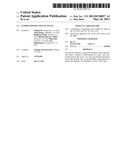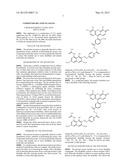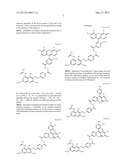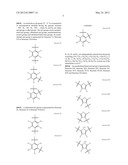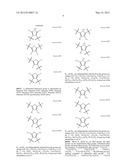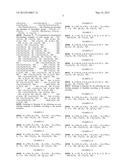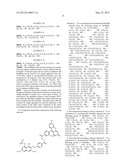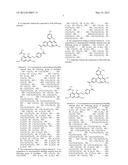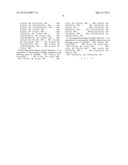Patent application title: Compounds related to assays
Inventors:
Jianjun He (Sunnyvale, CA, US)
Anita Hong (Cupertino, CA, US)
Qingheng Wang (Fremont, CA, US)
Raman Khosrow Afshar (San Jose, CA, US)
Ming Zhu (Fremont, CA, US)
Vera Rakhmanova (Foster City, CA, US)
Assignees:
AnaSpec Incorporated
IPC8 Class: AC07D31190FI
USPC Class:
534655
Class name: Polycyclo carbocyclic ring system having at least three cyclos the polycyclo ring system consists of three six-membered cyclos and has plural oxygens bonded directly thereto hetero ring containing
Publication date: 2012-05-24
Patent application number: 20120130057
Abstract:
The present invention is generally directed to thiol quantitation assays,
methods of performing the assays, and compounds used in the assays. It is
more specifically directed to assays that include one or more disulfides
and related molecules and methods. The disulfides contain a FRET pair.Claims:
1. A compound, wherein the compound is of the following structure:
##STR00012## wherein X--Y is a symmetrical or unsymmetrical disulfide
selected from the following group of disulfides:
--NH--CH2CH2--SS--CH2CH2NH--;
--NH--(C6H4)--SS--(C6H4)--NH--;
--NH--CH2CH2--SS--(C6H4)--NH--;
--NH--(C6H4)--SS--CH2CH2--NH--;
--NH--CH2CH2--SS--CH2CH2CH2--NH--;
--NH--CH2CH2CH2--SS--CH2CH2--NH--;
--NH--CH2CH2CH2--SS--CH2CH2CH2--NH--;
--NH--CH2CH2CH2CH2--SS--CH2CH2--NH--;
--NHCH2CH2CH2CH2--SS--CH2CH2CH2--NH--;
--NH--CH2CH2CH2CH2--SS--CH2CH2CH2CH.su-
b.2--NH--; --NH--CH2CH2OCH2CH2--SS--CH2CH2---
NH--; --NH--CH2CH2OCH2CH2--SS--CH2CH2CH2--NH--; --NH--CH2CH2OCH2CH2--SS--CH2CH2CH.s-
ub.2CH2--NH--;
--NH--CH2CH2OCH2CH2--SS--CH2CH2OCH2CH.-
sub.2--NH--;
--NH--CH2CH2--SS--CH2CH2OCH2CH2--NH;
--NH--CH2CH2CH2--SS--CH2CH2OCH2CH2--NH-
--; --NH--CH2CH2CH2CH2--SS--CH2CH2OCH2C-
H2--NH--; --NH--CH2CH2--SS--(C4H2O)--NH--;
--NH--CH2CH2CH2--SS--(C4H2O)--NH--;
--NH--CH2CH2CH2CH2--SS--(C4H2O)--NH--;
--NH--CH2CH2OCH2CH2--SS--(C4H2O)--NH--;
--NH--(C4H2O)--SS--CH2CH2--NH--;
--NH--(C4H2O)--SS--CH2CH2CH2--NH--;
--NH--(C4H2O)--SS--CH2CH2CH2CH2--NH--;
--NH--(C4H2O)--SS--CH2CH2OCH2CH2--NH--;
--NH--(C4H2O)--SS--(C4H2O)--NH--;
--NH--CH2CH2--SS--(C4H2S)--NH--;
--NH--CH2CH2CH2--SS--(C4H2S)--NH--;
--NH--CH2CH2CH2CH2--SS--(C4H2S)--NH--;
--NH--CH2CH2OCH2CH2--SS--(C4H2S)--NH--;
--NH--(C4H2S)--SS--CH2CH2--NH--;
--NH--(C4H2S)--SS--CH2CH2CH2--NH--;
--NH--(C4H2S)--SS--CH2CH2CH2CH2--NH--;
--NH--(C4H2S)--SS--CH2CH2OCH2CH2--NH--;
--NH--(C4H2S)--SS--(C4H2S)--NH--.
2. The compound according to claim 1, wherein X--Y is a symmetrical or unsymmetrical disulfide selected from the following group of disulfides: --NH--CH2CH2--SS--CH2CH2NH--; --NH--(C6H4)--SS--(C6H4)--NH--; --NH--CH2CH2--SS--(C6H4)--NH--; --NH--(C6H4)--SS--CH2CH2--NH--; --NH--CH2CH2--SS--CH2CH2CH2--NH--; --NH--CH2CH2CH2--SS--CH2CH2--NH--; --NH--CH2CH2CH2--SS--CH2CH2CH2--NH--; --NH--CH2CH2CH2CH2--SS--CH2CH2--NH--; --NHCH2CH2CH2CH2--SS--CH2CH2CH2--NH--; --NH--CH2CH2CH2CH2--SS--CH2CH2CH2CH.su- b.2--NH--.
3. The compound according to claim 2, wherein X--Y is a symmetrical or unsymmetrical disulfide selected from the following group of disulfides: --NH--CH2CH2--SS--CH2CH2NH--; --NH--(C6H4)--SS--(C6H4)--NH--; --NH--CH2CH2--SS--(C6H4)--NH--; --NH--(C6H4)--SS--CH2CH2--NH--; --NH--CH2CH2--SS--CH2CH2CH2--NH--; --NH--CH2CH2CH2--SS--CH2CH2--NH--; --NH--CH2CH2CH2--SS--CH2CH2CH2--NH--.
4. A compound, wherein the compound is of the following structure: ##STR00013## wherein X--Y is a symmetrical or unsymmetrical disulfide selected from the following group of disulfides: --NH--CH2CH2--SS--CH2CH2NH--; --NH--(C6H4)--SS--(C6H4)--NH--; --NH--CH2CH2--SS--(C6H4)--NH--; --NH--(C6H4)--SS--CH2CH2--NH--; --NH--CH2CH2--SS--CH2CH2CH2--NH--; --NH--CH2CH2CH2--SS--CH2CH2--NH--; --NH--CH2CH2CH2--SS--CH2CH2CH2--NH--; --NH--CH2CH2CH2CH2--SS--CH2CH2--NH--; --NHCH2CH2CH2CH2--SS--CH2CH2CH2--NH--; --NH--CH2CH2CH2CH2--SS--CH2CH2CH2CH.su- b.2--NH--; --NH--CH2CH2OCH2CH2--SS--CH2CH2--- NH--; --NH--CH2CH2OCH2CH2--SS--CH2CH2CH2--NH--; --NH--CH2CH2OCH2CH2--SS--CH2CH2CH.s- ub.2CH2--NH--; --NH--CH2CH2OCH2CH2--SS--CH2CH2OCH2CH.- sub.2--NH--; --NH--CH2CH2--SS--CH2CH2OCH2CH2--NH; --NH--CH2CH2CH2--SS--CH2CH2OCH2CH2--NH- --; --NH--CH2CH2CH2CH2--SS--CH2CH2OCH2C- H2--NH--; --NH--CH2CH2--SS--(C4H2O)--NH--; NH--CH2CH2CH2--SS --(C4H2O)--NH--; --NH--CH2CH2CH2CH2--SS--(C4H2O)--NH--; --NH--CH2CH2OCH2CH2--SS--(C4H2O)--NH--; --NH--(C4H2O)--SS--CH2CH2--NH--; --NH--(C4H2O)--SS--CH2CH2CH2--NH--; --NH--(C4H2O)--SS--CH2CH2CH2CH2--NH--; --NH--(C4H2O)--SS--CH2CH2OCH2CH2--NH--; --NH--(C4H2O)--SS--(C4H2O)--NH--; --NH--CH2CH2--SS--(C4H2S)--NH--; --NH--CH2CH2CH2--SS--(C4H2S)--NH--; --NH--CH2CH2CH2CH2--SS--(C4H2S)--NH--; --NH--CH2CH2OCH2CH2--SS--(C4H2S)--NH--; --NH--(C4H2S)--SS--CH2CH2--NH--; --NH--(C4H2S)--SS--CH2CH2CH2--NH--; --NH--(C4H2S)--SS--CH2CH2CH2CH2--NH--; --NH--(C4H2S)--SS--CH2CH2OCH2CH2--NH--; --NH--(C4H2S)--SS--(C4H2S)--NH--.
5. The compound according to claim 4, wherein X--Y is a symmetrical or unsymmetrical disulfide selected from the following group of disulfides: --NH--CH2CH2--SS--CH2CH2NH--; --NH--(C6H4)--SS--(C6H4)--NH--; --NH--CH2CH2--SS--(C6H4)--NH--; --NH--(C6H4)--SS--CH2CH2--NH--; --NH--CH2CH2--SS--CH2CH2CH2--NH--; --NH--CH2CH2CH2--SS--CH2CH2--NH--; --NH--CH2CH2CH2--SS--CH2CH2CH2--NH--; --NH--CH2CH2CH2CH2--SS--CH2CH2--NH--; --NHCH2CH2CH2CH2--SS--CH2CH2CH2--NH--; --NH--CH2CH2CH2CH2--SS--CH2CH2CH2CH.su- b.2--NH--.
6. The compound according to claim 5, wherein X--Y is a symmetrical or unsymmetrical disulfide selected from the following group of disulfides: --NH--CH2CH2--SS--CH2CH2NH--; --NH--(C6H4)--SS--(C6H4)--NH--; --NH--CH2CH2--SS--(C6H4)--NH--; --NH--(C6H4)--SS--CH2CH2--NH--; --NH--CH2CH2--SS--CH2CH2CH2--NH--; --NH--CH2CH2CH2--SS--CH2CH2--NH--; --NH--CH2CH2CH2--SS--CH2CH2CH2--NH--.
7. A compound, wherein the compound is of the following structure: ##STR00014## wherein X--Y is a symmetrical or unsymmetrical disulfide selected from the following group of disulfides: --NH--CH2CH2--SS--CH2CH2NH--; --NH--(C6H4)--SS--(C6H4)--NH--; --NH--CH2CH2--SS--(C6H4)--NH--; --NH--(C6H4)--SS--CH2CH2--NH--; --NH--CH2CH2--SS--CH2CH2CH2--NH--; --NH--CH2CH2CH2--SS--CH2CH2--NH--; --NH--CH2CH2CH2--SS--CH2CH2CH2--NH--; --NH--CH2CH2CH2CH2--SS--CH2CH2--NH--; --NHCH2CH2CH2CH2--SS--CH2CH2CH2--NH--; --NH--CH2CH2CH2CH2--SS--CH2CH2CH2CH.su- b.2--NH--; --NH--CH2CH2OCH2CH2--SS--CH2CH2--- NH--; --NH--CH2CH2OCH2CH2--SS--CH2CH2CH2--NH--; --NH--CH2CH2OCH2CH2--SS--CH2CH2CH.s- ub.2CH2--NH--; --NH--CH2CH2OCH2CH2--SS--CH2CH2OCH2CH.- sub.2--NH--; --NH--CH2CH2--SS--CH2CH2OCH2CH2--NH; --NH--CH2CH2CH2--SS--CH2CH2OCH2CH2--NH- --; --NH--CH2CH2CH2CH2--SS--CH2CH2OCH2C- H2--NH--; --NH--CH2CH2--SS--(C4H2O)--NH--; --NH--CH2CH2CH2--SS--(C4H2O)--NH--; --NH--CH2CH2CH2CH2--SS--(C4H2O)--NH--; --NH--CH2CH2OCH2CH2--SS--(C4H2O)--NH--; --NH--(C4H2O)--SS--CH2CH2--NH--; --NH--(C4H2O)--SS--CH2CH2CH2--NH--; --NH--(C4H2O)--SS--CH2CH2CH2CH2--NH--; --NH--(C4H2O)--SS--CH2CH2OCH2CH2--NH--; --NH--(C4H2O)--SS--(C4H2O)--NH--; --NH--CH2CH2--SS--(C4H2S)--NH--; --NH--CH2CH2CH2--SS--(C4H2S)--NH--; --NH--CH2CH2CH2CH2--SS--(C4H2S)--NH--; --NH--CH2CH2OCH2CH2--SS--(C4H2S)--NH--; --NH--(C4H2S)--SS--CH2CH2--NH--; --NH --(C4H2S)--SS--CH2CH2CH2--NH--; --NH--(C4H2S)--SS--CH2CH2CH2CH2--NH--; --NH--(C4H2S)--SS--CH2CH2OCH2CH2--NH--; --NH--(C4H2S)--SS--(C4H2S)--NH--.
8. The compound according to claim 7, wherein X--Y is a symmetrical or unsymmetrical disulfide selected from the following group of disulfides: --NH--CH2CH2--SS--CH2CH2NH--; --NH--(C6H4)--SS--(C6H4)--NH--; --NH--CH2CH2--SS--(C6H4)--NH--; --NH--(C6H4)--SS--CH2CH2--NH--; --NH--CH2CH2--SS--CH2CH2CH2--NH--; --NH--CH2CH2CH2--SS--CH2CH2--NH--; --NH--CH2CH2CH2--SS--CH2CH2CH2--NH--; --NH--CH2CH2CH2CH2--SS--CH2CH2--NH--; --NHCH2CH2CH2CH2--SS--CH2CH2CH2--NH--; --NH--CH2CH2CH2CH2--SS--CH2CH2CH2CH.su- b.2--NH--.
9. The compound according to claim 8, wherein X--Y is a symmetrical or unsymmetrical disulfide selected from the following group of disulfides: --NH--CH2CH2--SS--CH2CH2NH--; --NH--(C6H4)--SS--(C6H4)--NH--; --NH--CH2CH2--SS--(C6H4)--NH--; --NH--(C6H4)--SS--CH2CH2--NH--; --NH--CH2CH2--SS--CH2CH2CH2--NH--; --NH--CH2CH2CH2--SS--CH2CH2--NH--; --NH--CH2CH2CH2--SS--CH2CH2CH2--NH--.
Description:
CROSS-REFERENCE TO RELATED APPLICATION
[0001] This application is a continuation of U.S. patent application Ser. No. 12/804,739, filed Jul. 28, 2010, which claims priority to U.S. Provisional Patent Application Ser. No. 61/273,186, filed on Jul. 30, 2009, the entire disclosures of which are incorporated by reference.
FIELD OF THE INVENTION
[0002] The present invention is generally directed to thiol quantitation assays, methods of performing the assays, and compounds used in the assays. It is more specifically directed to assays that include one or more disulfides and related molecules and methods.
BACKGROUND OF THE INVENTION
[0003] Thiols play a number of important roles in cellular biochemistry. In certain cases they determine protein structure; in others they serve as covalent catalysts; in still others they maintain appropriate oxidation states of proteins and cells. Accordingly, thiol detection and quantitation is important to understanding cellular processes.
[0004] Several assays have been developed for thiol quantitation. One such assay is the Thiol and Sulfide Quantitation Kit commercialized by Invitrogen. The kit includes the following: Papain-SSCH3, a disulfide-inhibited papain derivative; L-BAPNA, a chromogenic papain substrate; DTNB (Ellman's reagent) for calibrating the assay; cystamine; L-cysteine, a thiol standard; and a buffer. According to product literature, the chemical basis for the assay involves the following reactions: 1) Papain-SSCH3 is activated in the presence of thiols. 2) Active papain cleaves the substrate L-BAPNA, which releases the p-nitroaniline chromophore. 3) Protein thiols exchange with cystamine to generate 2-mercaptoethylamine, which is detected.
[0005] Another thiol quantitation assay has been worked on at Marquette University by Sem and Pullela. See U.S. patent application Ser. No. 11/512,485. Their work focuses on hydroxyl-coumarin-based disulfides, which reportedly react with sulfides present in an assay well. In a related publication the researches noted it was difficult to find a molecule that worked effectively in an assay framework. See, The FASEB Journal, 2008; 22:1059.3.
[0006] Despite the efforts discussed above, there is still a need for novel thiol quantitation assays that meet the unmet needs of various researchers.
SUMMARY OF THE INVENTION
[0007] The present invention is generally directed to thiol quantitation assays, methods of performing the assays, and compounds used in the assays. It is more specifically directed to assays that include one or more disulfides and related molecules and methods.
[0008] In a method aspect, the present invention provides a method of quantifying a thiol in a sample. The method comprises the steps of a) contacting the sample with a disulfide; and, b) detecting fluorescence from a cleavage product of the disulfide after the cleavage product has been excited. The disulfide is of the following structure:
##STR00001##
wherein R1 is OH or NH2, R2 is H or SO3--, R3 is H or SO3--, and R4 is NH2+ or O; and wherein X--Y is a symmetrical or unsymmetrical disulfide having the general structure --NH--R5--SS--R6--NH--, where R5 and R6 are either aryl groups or alkyl groups.
[0009] In a compound aspect, the present invention provides a disulfide of the following structure:
##STR00002##
wherein R1 is OH or NH2, R2 is H or SO3--, R3 is H or SO3--, and R4 is NH2+ or O; and wherein X--Y is a symmetrical or unsymmetrical disulfide having the general structure --NH--R5--SS--R6--NH--, where R5 and R6 are either aryl groups or alkyl groups.
DETAILED DESCRIPTION OF THE INVENTION
[0010] The present assays include one or more disulfide compounds. The disulfides contain a donor-acceptor FRET pair. When the disulfide is added to an assay medium, thiols present in the medium cleave the disulfide. This allows the emission spectrum of the donor portion of the pair to be observed; a thiol is detected and can be quantified according to the intensity of the emission.
[0011] Disulfides according to the present invention have a general structure as shown below (Structure I):
##STR00003##
R1 is OH or NH; R2 is H or SO3--; R3 is H or SO3--; and R4 is O or NH2+. "X--Y" is a symmetrical or unsymmetrical disulfide having the general structure --NH--R5--SS--R6--NH--, where R5 and R6 are either aryl groups or alkyl groups.
[0012] Structure II and Structure III below depict two more specific structures of disulfides of the present invention, where the substitution pattern on one aryl moiety is defined. The substituents for these structures are the same as for Structure I.
##STR00004##
[0013] Structure IV and Structure V below depict two still more specific structures of disulfides of the present invention, where the substitution pattern on one aryl moiety and the tricyclic moiety are defined. Substituents "X--Y" for these structures are the same as for Structure I.
##STR00005##
[0014] As noted above, the group "X--Y" is a symmetrical or unsymmetrical disulfide having the general structure --NH--R5--SS--R6--NH--, where R5 and R6 are either aryl groups or alkyl groups. The aryl groups can be unsubstituted aryl groups, substituted aryl groups, unsubstituted heteroaryl groups and substituted heteroaryl groups. An unsubstituted aryl group is represented by Structure VI, Structure VII or Structure VIII below.
##STR00006##
[0015] A substituted aryl group is represented by Structure IX, Structure X or Structure XI below.
##STR00007##
R7, R8, R9 and R10 are independently selected from the group consisting of H, CH3, CH2CH3, CH2CH2CH3, CH(CH3)2, F, Cl, Br, I, CN, OCH3, OCH2CH3, CO2CH3, CO2CH2CH3, N(CH3)2, N(CH2CH3)2, SCH3, SCH2CH3; at least one of the substituents is not H.
[0016] An unsubstituted heteroaryl group is represented by Structure XII, Structure XIII, Structure XIV, Structure XV, Structure XVI, Structure XVII, Structure XVIII, Structure XIX and Structure XX below.
##STR00008##
[0017] A substituted heteroaryl group is represented by Structure XXI, Structure XXII, Structure XXIII, Structure XXIV, Structure XXV, Structure XXVI, Structure XXVII, Structure XXVIII and Structure XXIX below.
##STR00009##
R11 and R12 are independently selected from the group consisting of H, CH3, CH2CH3, CH2CH2CH3, CH(CH3)2, F, Cl, Br, I, CN, OCH3, OCH2CH3, CO2CH3, CO2CH2CH3, N(CH3)2, N(CH2CH3)2, SCH3, SCH2CH3; at least one of the substituents is not H.
##STR00010##
R13 and R14 are independently selected from the group consisting of H, CH3, CH2CH3, CH2CH2CH3, CH(CH3)2, F, Cl, Br, I, CN, OCH3, OCH2CH3, CO2CH3, CO2CH2CH3, N(CH3)2, N(CH2CH3)2, SCH3, SCH2CH3; at least one of the substituents is not H.
##STR00011##
R15 and R16 are independently selected from the group consisting of H, CH3, CH2CH3, CH2CH2CH3, CH(CH3)2, F, Cl, Br, I, CN, OCH3, OCH2CH3, CO2CH3, CO2CH2CH3, N(CH3)2, N(CH2CH3)2, SCH3, SCH2CH3; at least one of the substituents is not H.
[0018] Where R5 and/or R6 are alkyl groups, the alkyl groups can be unsubstituted alkyl groups, substituted alkyl groups and heteroalkyl groups. The following are non-limiting examples of unsubstituted alkyl groups: --CH2CH2--; --CH2CH2CH2--; --CH(CH3)CH2--; --CH(CH3)CH2CH2--; --CH2CH(CH3)CH2--. The following are non-limiting examples of substituted alkyl groups: --CH(CO2CH3)CH2--; --CH(CO2CH2CH3)CH2--; --CH2CH(OCH3)CH2--; --CH2CH(CN)CH2--; --CH2CH(CO2CH3)CH2--; --CH2CH(CH2CO2CH3)CH2--; --CH2CH(OCH3)CH2CH2--. The following are non-limiting examples of heteroalkyl groups: --CH2CH2--O--CH2CH2--; --CH2CH2--N[C(O)CH3]--CH2CH2--; --CH2CH2--S--CH2CH2--.
[0019] The group "X--Y" is symmetrical or asymmetrical. Non-limiting examples of such groups are: --NH--CH2CH2--SS--CH2CH2--NH--; --NH--(C6H4)--SS--(C6H4)--NH--; --NH--CH2CH2--SS--(C6H4)--NH--; --NH--(C6H4)--SS--CH2CH2--NH--; --NH--CH2CH2--SS--CH2CH2CH2--NH--; --NH--CH2CH2CH2--SS--CH2CH2--NH--; --NH--CH2CH2CH2--SS--CH2CH2CH2--NH--; --NH--CH2CH2CH2CH2--SS--CH2CH2--NH--; --NH--CH2CH2CH2CH2--SS--CH2CH2CH2--NH-- -; --NH--CH2CH2CH2CH2--SS--CH2CH2CH2CH.- sub.2--NH--; --NH--CH2CH2--OCH2CH2--SS--CH2CH2--NH--; --NH--CH2CH2OCH2CH2--SS--CH2CH2CH2--NH- --; --NH--CH2CH2OCH2CH2--SS--CH2CH2CH2C- H2--NH--; --NH--CH2CH2OCH2CH2--SS--CH2CH2OCH2CH.- sub.2--NH--; --NH--CH2CH2--SS--CH2CH2OCH2CH2--NH--; --NHCH2CH2CH2--SS--CH2CH2OCH2CH2NH--; --NHCH2CH2CH2CH2--SS--CH2CH2OCH2CH.sub- .2NH--; --NH--CH2CH2--SS--(C4H2O)--NH--; --NH--CH2CH2CH2--SS--(C4H2O)--NH--; --NH--CH2CH2CH2CH2--SS--(C4H2O)--NH--; --NH--CH2CH2OCH2CH2--SS--(C4H2O)--NH--; --NH--(C4H2O)--SS--CH2CH2--NH--; --NH--(C4H2O)--SS--CH2CH2CH2--NH--; --NH--(C4H2O)--SS--CH2CH2CH2CH2--NH--; --NH--(C4H2O)--SS--CH2CH2OCH2CH2--NH--; --NH(C4H2O)--SS--(C4H2O)--NH--; --NH--CH2CH2--SS--(C4H2S)--NH--; --NH--CH2CH2CH2--SS--(C4H2S)--NH--; --NH--CH2CH2CH2CH2--SS--(C4H2S)--NH--; --NH--CH2CH2OCH2CH2--SS--(C4H2S)--NH--; --NH--(C4H2S)--SS--CH2CH2--NH--; --NH--(C4H2S)--SS--CH2CH2CH2--NH--; --NH--(C4H2S)--SS--CH2CH2CH2CH2--NH--; --NH--(C4H2S)--SS--CH2CH2OCH2CH2--NH--; --NH(C4H2S)--SS--(C4H2S)--NH--.
[0020] Referring to Structure II, the following are non-limiting examples of disulfides according to the present invention:
EXAMPLE 1
[0021] R1 is NH2; R2 is SO3--; R3 is SO3--; R4 is NH2+; X--Y is --NH--CH2CH2--SS--CH2CH2--NH--.
EXAMPLE 2
[0022] R1 is NH2; R2 is SO3--; R3 is SO3--; R4 is NH2+; X--Y is --NH--(pC6H4)--SS--(pC6H4)--NH--.
EXAMPLE 3
[0023] R1 is NH2; R2 is SO3--; R3 is SO3--; R4 is NH2+; X--Y is --NH--CH2CH2--SS--CH2CH2CH2--NH--.
EXAMPLE 4
[0024] R1 is NH2; R2 is SO3--; R3 is SO3--; R4 is NH2+; X--Y is --NH--CH2CH2CH2--SS--CH2CH2--NH--.
EXAMPLE 5
[0025] R1 is NH2; R2 is SO3--; R3 is SO3--; R4 is NH2+; X--Y is --NH--CH2CH2--SS--(pC6H4)--NH--.
EXAMPLE 6
[0026] R1 is NH2; R2 is SO3--; R3 is SO3--; R4 is NH2+; X--Y is --NH--(pC6H4)--SS--CH2CH2--NH--.
EXAMPLE 7
[0027] R1 is OH; R2 is H; R3 is H; R4 is O; XY is --NHCH2CH2--SS--CH2CH2--NH--.
EXAMPLE 8
[0028] R1 is OH; R2 is H; R3 is H; R4 is O; XY is --NH--(pC6H4)--SS--(pC6H4)--NH--.
EXAMPLE 9
[0029] R1 is OH; R2 is H; R3 is H; R4 is O; XY is --NH--CH2CH2--SS--CH2CH2CH2--NH--.
EXAMPLE 10
[0030] R1 is OH; R2 is H; R3 is H; R4 is O; XY is --NH--CH2CH2CH2--SS--CH2CH2--NH--.
EXAMPLE 11
[0031] R1 is OH; R2 is H; R3 is H; R4 is O; XY is --NH--CH2CH2--SS--(pC6H4)--NH--.
EXAMPLE 12
[0032] R1 is OH; R2 is H; R3 is H; R4 is O; XY is --NH--(pC6H4)--SS--CH2CH2--NH--.
[0033] Referring to Structure III, the following are non-limiting examples of disulfides according to the present invention:
EXAMPLE 13
[0034] R1 is NH2; R2 is SO3--; R3 is SO3--; R4 is NH2+; X--Y is --NH--CH2CH2--SS--CH2CH2--NH--.
EXAMPLE 14
[0035] R1 is NH2; R2 is SO3--; R3 is SO3--; R4 is NH2+; X--Y is --NH--(pC6H4)--SS--(pC6H4)--NH--.
EXAMPLE 15
[0036] R1 is NH2; R2 is SO3--; R3 is SO3--; R4 is NH2+; X--Y is --NH--CH2CH2--SS--CH2CH2CH2--NH--.
EXAMPLE 16
[0037] R1 is NH2; R2 is SO3--; R3 is SO3--; R4 is NH2+; X--Y is --NH--CH2CH2CH2--SS--CH2CH2--NH--.
EXAMPLE 17
[0038] R1 is NH2; R2 is SO3--; R3 is SO3--; R4 is NH2+; X--Y is --NH--CH2CH2--SS--(pC6H4)--NH--.
EXAMPLE 18
[0039] R1 is NH2; R2 is SO3--; R3 is SO3--; R4 is NH2+; X--Y is --NH--(pC6H4)--SS--CH2CH2--NH--.
EXAMPLE 19
[0040] R1 is OH; R2 is H; R3 is H; R4 is O; XY is --NHCH2CH2--SS--CH2CH2--NH--.
EXAMPLE 20
[0041] R1 is OH; R2 is H; R3 is H; R4 is O; XY is --NH--(pC6H4)--SS--(pC6H4)--NH--.
EXAMPLE 21
[0042] R1 is OH; R2 is H; R3 is H; R4 is O; XY is --NH--CH2CH2--SS--CH2CH2CH2--NH--.
EXAMPLE 22
[0043] R1 is OH; R2 is H; R3 is H; R4 is O; XY is --NH--CH2CH2CH2--SS--CH2CH2--NH--.
EXAMPLE 23
[0044] R1 is OH; R2 is H; R3 is H; R4 is O; XY is --NH--CH2CH2--SS--(pC6H4)--NH--.
EXAMPLE 24
[0045] R1 is OH; R2 is H; R3 is H; R4 is O; XY is --NH--(pC6H4)--SS--CH2CH2--NH--.
[0046] The disulfides of the present invention are synthesized according to methods known to those skilled in the art. Examples of reaction types that are used to synthesize the disulfides can be found in U.S. patent application Ser. No. 11/512,485, which is incorporated-by-reference into this document for all purposes. One such reaction type is the condensation of a diamine (e.g., H2N--CH2CH2--SS--CH2CH2--NH2 and H2N--(C6H4)--SS--(C6H4)--NH2) with an activated carboxylic acid moiety of a FRET pair donor and a FRET pair acceptor, which is typically performed in two separate synthetic steps.
[0047] Assays of the present invention are performed by bringing a disulfide of the present invention in contact with a sample thought to include one or more types of thiols. As noted above, the disulfides contain a donor-acceptor FRET pair. When the disulfide is added to the sample, thiols present in the sample cleave the disulfide. Cleavage ensures that the acceptor no longer quenches the emission spectrum of the donor portion of the FRET pair. Excitation of the donor accordingly results in fluorescence, which can be measured.
User Contributions:
Comment about this patent or add new information about this topic:

